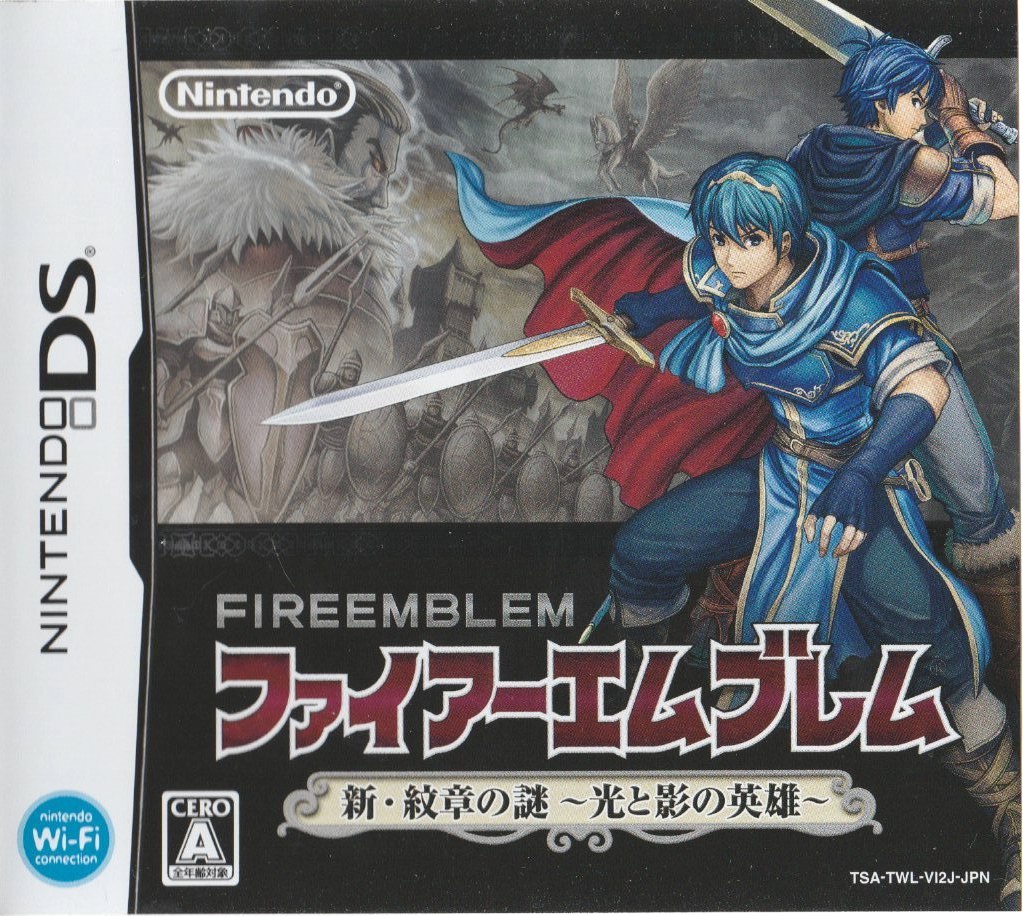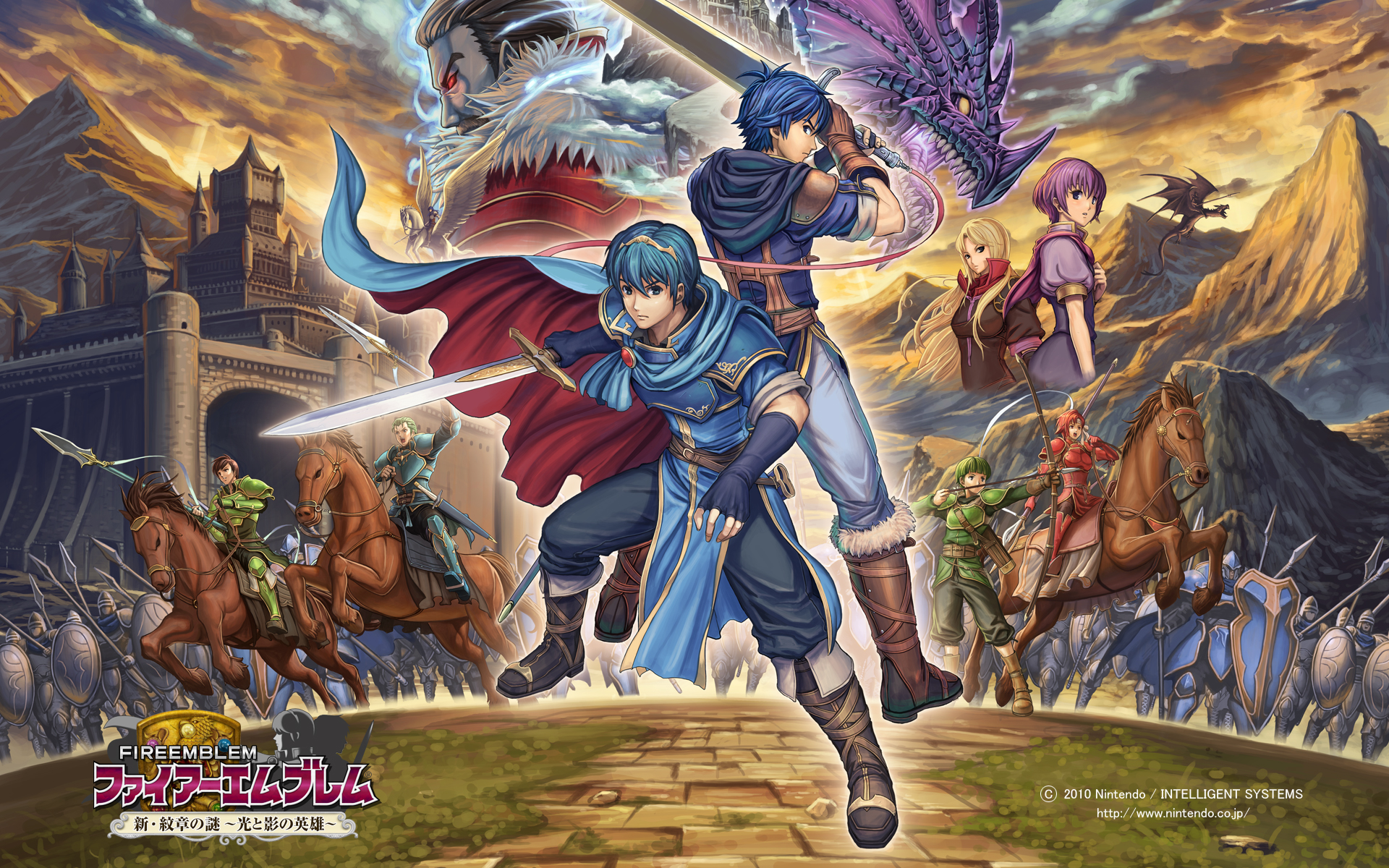FIRE EMBLEM
NEW MYSTERY OF THE EMBLEM
HEROES OF LIGHT AND SHADOW

Fire Emblem: New Mystery of the Emblem: Heroes of Light and Shadow isn’t the only Fire Emblem game to have two subtitles, but it is the longest one by a significant amount. It’s also the Fire Emblem game that is the hardest to explain in generic terms: sure, you could just say it’s “the sequel to Shadow Dragon”, but really it’s a remake of a sequel—but that sequel was in itself a remake, and packaged with one—or, well—
Let me start over with a brief (very brief) history lesson.
The first Fire Emblem game is about Marth. With me so far? Great. The third Fire Emblem game was a sequel to the first one (ignore the second game for now), but just in case you missed the first game the first time around, it also included a version of those same events—trimmed slightly, cutting out some chaff chapters, characters, and game mechanics. That game—Mystery of the Emblem, game #3—is widely considered one of the best in the series. I’ve never finished it, so I can’t speak to its quality, but I can say this: I love New Mystery, which remakes only the latter half: the sequel to the original game.
All caught up? Great. Let’s go.
Fire Emblem: New Mystery of the Emblem was released in 2010 for the Nintendo DS (which stands for Digital System), the 12th (or 13th) game in the series. You already know what it’s a remake of. It tells the continued story of Marth, now king of Altea, and Everything Going To Shit. It also tells the story of Kris, Marth’s new trusted knight—that’s you!
That’s right! It’s you! They put you in a Fire Emblem game! Congratulations!
New Mystery is the first time that Fire Emblem does a playable avatar: the default name is Kris, but you can choose your player character’s name, as well as their class, gender, appearance, and “past, present, and future” (which essentially determines your stats). Kris is a playable unit alongside Marth throughout the game, and takes you through the tutorial section (where you get to know their funky squad in the army) as well as frequently showing up in cutscenes. While you don’t need to deploy them in every chapter, when you do, their death is a game over just the same as if it was Marth.
A lot of people on the internet decry Kris’s inclusion, and I think that is patently stupid. They say Kris takes away character moments from Jagen, who fulfilled several of the same cutscene conversation roles in the original, but I say, who gives a shit about Jagen? Kris is YOU! Additionally, since Kris’s squad also appears in the original (but sans any sort of justification or character), the remake and extended prologue where you get to know these characters allows for some actual character moments, and the setting up of the game’s big subplot.
Since this game is a sequel to a game with a large cast, and it keeps basically every single playable character from that original game and then adds more, it has a truly obscene cast size: eighty-one playable characters. But, since it’s a sequel and it begins by cutting your party down to about six people, it then allows for a trickling back in of those characters bit by bit in a very compelling manner: the first time I played this game, I kept going “Oh my god! It’s [X]!” over and over again, which is incredible! It made me care about, like, Cain! Who gives a shit about Cain? I don’t! But I was excited to see him again! So cheers for that, New Mystery.
I won’t talk about the plot in great detail here, but it’s much more compelling (and importantly, compellingly-told) than the plot in Shadow Dragon. The writing is...better..? I’ll be real, it’s been long enough since I played this game that I don’t remember the quality of the moment-to-moment dialogue and event writing very well. But perhaps it’s the prior knowledge given to you, the player, since this is a sequel building off of a first game that really becomes a setup for the much more dynamic story of the sequel; or perhaps, say, it’s the fact that this game lets you look at a minimap and charts of characters at any time that allow you to actually know what’s going on. Legitimately, just having a little map that I could scroll around whenever I wanted to and have different countries become highlighted with their names was so helpful—not to mention the robust web of relationships that the game lets you scroll between, sorting characters by nation of origin and letting you skip between them when one or another knows each other.
There’s a heightened focus on individual character in this game overall, at least compared to its direct predecessor. At long last, the folks at Intelligent Systems realized that hey, these “support conversation” things that allow any given character to have potential depth without requiring shoehorning them into the larger narrative, and whose removal 90% of the fanbase was really pissed about—maybe we should bring them back!
Thank fuck!
Support conversations, for the uninitiated, are one of the Fire Emblem series’s defining characteristics, but it took a while for them to get there. Essentially, the way they work is that any given character has about 3-5 potential “partners” for supporting, on average, who they can build support points with. The methods change between games—sometimes it’s standing next to each other, or healing each other, or carrying each other around, or just being in the same battle—but the important thing is that, once you reach a specific level (usually one of 3 tiers, “C”, “B”, and “A” rank), those two characters gain stat bonuses from standing near each other, and you get to see a neat little conversation between them. Despite being a series staple, support conversations only actually showed up in the sixth game in the series, The Binding Blade, where they...worked? But the actual content of the conversations was frequently...shall we say, less than interesting? Part of my saying this is my own bias against The Binding Blade and its flat caricatures of characters in the sixth game in the series, but the support conversations in that game tended towards the shorter and less revealing of character side. I can’t speak to the next two games in the series, but come Path of Radiance, we’re getting actual character revelations and arcs in their supports, and the series generally builds from there.
Except for the next two games, Radiant Dawn and Shadow Dragon, which remove support conversations entirely. Oops!
So the reincarnation of support conversations in New Mystery is a delightful feature. Every character in the game can hold conversations with Kris—which is kind of funny, considering that in fiction they’re literally just some rando knight—but most characters can also speak to other friends, family, lovers, or what-have-you, which is really nice! Additionally, this was the first game in the series to not place a limit on how many conversations each character can hold: previously, it was limited to five, which is staggeringly low when you consider that some characters could hold potentially eighteen support conversations.
So this addition of support conversations helps the game massively, especially as they’re longer, more frequent, and generally more complex than the last time Fire Emblem introduced them back in The Binding Blade. And this ties in with a more complex story than the last installment as well.

Again, I’ll keep it rather nonspecific here, but where in Shadow Dragon the plot-as-you-see-it was limited to “Marth! Go here! Seize this castle!” repeated ad infinitum, with no options for referencing where you were going next or really why, the plot of New Mystery involves betrayal! MacGuffin hunting! Assassination attempts! Hidden identities! Fleeing from large armies! Fighting those you once called friends! And divorce!
And all of this is helped so much by two things: one, the plot is mostly based around characters you already know, which makes it work better when you encounter them in new ways (as enemies, although usually they are eventually recruitable). Also, at this point in the series’s history (way back when the original came out), the creators started mixing up how they could tell stories with gameplay. Now, you have to rescue two characters trapped in the middle of the woods under attack, or run from a pursuing army, or hunt down thieves before they get away. While technically every objective in every chapter is just “kill the boss and seize the castle” just as it was in the last game, we are seeing the beginnings of the focus on plot that will pay dividends in the two sequels to the original, non-remake version of this game: that is, Genealogy of the Holy War and Thracia 776, my two candidates for “best title of Fire Emblem game.” In Genealogy, the plot involves complex political machinations, betrayal, and incest (framed as a bad thing, not to be confused with the incest in Fates oh god), and in Thracia, this comes through to the game mechanics even more with Escape objectives showing up frequently, where every single character must make it through the map before Leif (that game’s Marth equivalent) can leave—otherwise they’ll be left behind.
New Mystery came at a time when Fire Emblem was doing terribly, by the by: Shadow Dragon performed so poorly that this game was never officially released outside of Japan, being the first in and still only game in the series to do so since 2003. This game performed poorly too, and spelled out an encroaching death knell for Fire Emblem. Fortunately for the series, the next game—Awakening, planned to be "ending on a high note" for the series—performed magnificently in sales and saved the series. But even as a death knell, I think this game is pretty great.
To be clear, it’s still not a perfect game: the support system is obtuse and doesn’t tell you who can support or how close they are to reaching a new rank, the art style is still sort of boring, and the plot, for all its exciting turnabouts, is weirdly revisionist to the last game and pulls a lot of damsels-in-distress in largely the most boring way possible. But it is still very exciting, especially coming directly from Shadow Dragon as I was, and a great time, with even more replayability based around the Avatar/Kris functionality. Not to mention the actually great and legitimately emotionally compelling subplot added in the remake! Or the way that seemingly all the Kris conversations were written with Kris-as-a-boy first or intentionally, so that Kris-as-a-girl has a lot, I mean a lot of deeply homoerotic friendships. It’s good stuff.
And because of all that, New Mystery still stands out as one of my favorite games in the series (alongside, if you’re curious, Thracia 776 and Path of Radiance). It’s fuckin’ phenomenal, dude! Give it a whirl if you’ve played Shadow Dragon.
(Plus, it has the remake of Archanea Saga, some of my favorite Fire Emblem levels actually ever, which I’ll cover in a later installment, and is by far the easiest way to play them.)
Overall rating: 9/10. Play Shadow Dragon first, though.